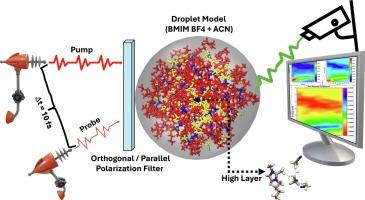Ultrafast excited-state dynamics and transient absorption spectra of [BMIM][BF₄] in acetonitrile: A QM/MM–trajectory surface hopping study
IF 5.2
2区 化学
Q2 CHEMISTRY, PHYSICAL
引用次数: 0
Abstract
In this study, we aimed to investigate the transient absorption spectra of 1-butyl-3-methylimidazolium tetrafluoroborate in acetonitrile by analyzing excited-state absorption and stimulated emission signals, using the trajectory surface hopping method. All calculations performed based on classical molecular dynamics and quantum mechanics were conducted using 30 Wigner sampling at room temperature. Quantum mechanical calculations were performed using B3LYP/6–311++G(d,p) level theory, and molecular mechanics calculations were performed using the AMBER suite program. The 30 different distributions of initial geometries derived from sampling significantly impacted the results of the excited-state dynamics and transient absorption spectra over a time period of ∼190 fs. The Tamm-Dancoff approximation was chosen for transient absorption spectrum calculations because the de-excitation effects could not be considered when determining the transition dipole moments. The UV spectrum and population decay were investigated within the ∼180-trajectory ensemble. The simulations capture ultrafast S2 → S1 internal conversion (∼30 fs), a persistent low-energy excited-state absorption band at 0.8–1.2 eV, and stimulated emission features at 4–6 eV, in strong agreement with experimental transient absorption measurements. Bond-length heatmaps reveal excitation-induced restructuring of solvation shells and ion-pair contacts, while polarization-dependent spectra highlight anisotropic transition dipole moment orientations. These results bridge molecular-level structural dynamics with measurable transient absorption signatures, validating the computational protocol and providing predictive insight for tailoring ultrafast photophysics in ionic liquid–solvent systems.

[BMIM][BF₄]在乙腈中的超快激发态动力学和瞬态吸收光谱:QM/ mm轨迹表面跳变研究
本研究采用轨迹表面跳变法,通过分析激发态吸收和受激发射信号,研究了1-丁基-3-甲基咪唑在乙腈中的瞬态吸收光谱。所有基于经典分子动力学和量子力学的计算都是在室温下使用30维格纳采样进行的。量子力学计算采用B3LYP/ 6-311 ++G(d,p)能级理论,分子力学计算采用AMBER suite程序。30种不同的初始几何形状分布对激发态动力学和瞬态吸收光谱在~ 190fs的时间周期内的结果有显著影响。暂态吸收谱计算采用tam - dancoff近似,因为在确定跃迁偶极矩时不能考虑去激发效应。在~ 180轨迹系综内研究了紫外光谱和种群衰减。模拟捕获了超快的S2→S1内部转换(~ 30 fs), 0.8-1.2 eV的持续低能激发态吸收带,以及4-6 eV的受激发射特征,与实验瞬态吸收测量结果非常吻合。键长热图揭示了激发引起的溶剂化壳和离子对接触的重组,而极化相关光谱则突出了各向异性跃迁偶极矩方向。这些结果将分子水平的结构动力学与可测量的瞬态吸收特征联系起来,验证了计算方案,并为离子液体-溶剂系统中的超快光物理提供了预测见解。
本文章由计算机程序翻译,如有差异,请以英文原文为准。
求助全文
约1分钟内获得全文
求助全文
来源期刊

Journal of Molecular Liquids
化学-物理:原子、分子和化学物理
CiteScore
10.30
自引率
16.70%
发文量
2597
审稿时长
78 days
期刊介绍:
The journal includes papers in the following areas:
– Simple organic liquids and mixtures
– Ionic liquids
– Surfactant solutions (including micelles and vesicles) and liquid interfaces
– Colloidal solutions and nanoparticles
– Thermotropic and lyotropic liquid crystals
– Ferrofluids
– Water, aqueous solutions and other hydrogen-bonded liquids
– Lubricants, polymer solutions and melts
– Molten metals and salts
– Phase transitions and critical phenomena in liquids and confined fluids
– Self assembly in complex liquids.– Biomolecules in solution
The emphasis is on the molecular (or microscopic) understanding of particular liquids or liquid systems, especially concerning structure, dynamics and intermolecular forces. The experimental techniques used may include:
– Conventional spectroscopy (mid-IR and far-IR, Raman, NMR, etc.)
– Non-linear optics and time resolved spectroscopy (psec, fsec, asec, ISRS, etc.)
– Light scattering (Rayleigh, Brillouin, PCS, etc.)
– Dielectric relaxation
– X-ray and neutron scattering and diffraction.
Experimental studies, computer simulations (MD or MC) and analytical theory will be considered for publication; papers just reporting experimental results that do not contribute to the understanding of the fundamentals of molecular and ionic liquids will not be accepted. Only papers of a non-routine nature and advancing the field will be considered for publication.
 求助内容:
求助内容: 应助结果提醒方式:
应助结果提醒方式:


